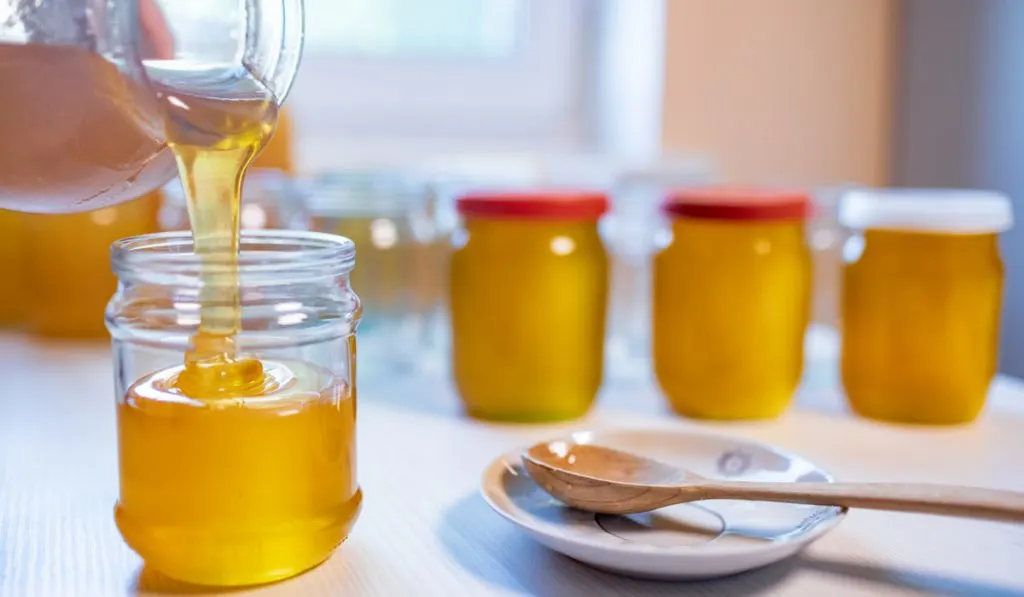*This post may have affiliate links, which means I may receive commissions if you choose to purchase through links I provide (at no extra cost to you). As an Amazon Associate I earn from qualifying purchases. Please read my disclaimer for additional details..
Honey has so many uses. To know the amount of honey to consume or use in a specific recipe, you need to know the weight of honey. How much does honey weigh? Is the weight of every brand of honey the same?
If different honey can have different weights, what factors affect the weight of honey? This article will answer all these questions and also give you some really cool facts about honey.
How much does honey weigh?
The easiest way to tell the weight of honey without a scale is to look at the label on the package of the honey. A 16oz jar of honey weighs 16oz.
If, however, you want to know how much honey will fill a 16oz container, you need to know the type of honey and other factors that determine the weight of honey.

What is honey made of? How do the ingredients in honey affect the weight of honey? Let us discuss in detail the average weight of honey and the factors that affect the weight of honey. Also, we will express the weight of honey in measurement units that you can understand.
Table of Contents
Knowing the Weight of Different Kinds of Honey
Why are there “different kinds of honey” if all honey is produced by bees? Even though honey is produced by bees, the flower from which bees collect nectar to produce honey is different from place to place and from season to season.

Honey that is made with just the nectar of a particular flower is called varietal honey. Varietal honey is made when beekeepers place a beehive amidst 50-100 miles of the flower of choice.
The weight of honey produced from one flower differs from the weight when produced from another flower. The weight of differs according to the mixtures of flowers used.
Some flowers from which bees collect nectar, and the weight of a gallon of honey produced from the nectar of the flowers are given below:

- Alfalfa honey: 11.44 lbs
- Buckwheat honey: 12 lbs
- Wildflower honey: 12 lbs
- Black locust honey: 12 lbs
- Basswood or linden: 12 lbs
- Aster honey: more than 12lbs
Judging from the list above, we can conclude that the average weight of a gallon of honey is 12 lbs. Now that you know the weight of a gallon of honey, you can tell how much a teaspoon, cup, or even a liter of honey would weigh.
Let us discuss other factors that affect the weight of honey.
Other Factors that Affect the Weight of Honey
What can affect the weight of honey? You are about to find out.
1. Moisture
The moisture or water content in honey affects the weight. The best honey has below 20% moisture. Any honey with more than 20% moisture can easily ferment. The higher the moisture content of honey, the higher the weight of honey.
If a gallon of honey weighs more than it should, the moisture content of the honey might be higher than it should be.
2. Region and Season
What do region and season have to do with honey, does it affect the weight? Region and season do not only affect the availability of flowers used to make honey, they differ in humidity. Humidity is the measurement of water vapor in the atmosphere.
Remember that moisture affects the weight of honey. If a region or season is humid, honey made in that region or season will have more moisture, therefore, be heavier than honey produced in more arid environments.
3. Commercialization Procedures
The processes involved in producing, packaging, and transporting honey differ from factory to factory. Some brands might sell more diluted honey while others will sell unprocessed wild honey.
The commercialization procedures of honey entail that the weight of honey might be different, not just because of the nectar used to make the honey, but because of the brand of honey.
4. Storage

The best way to store honey is to keep it in an airtight glass container. If you expose your honey to air, it will absorb some moisture from the atmosphere and start to ferment. When your honey absorbs more moisture, it becomes weightier.
Truthfully, there are so many factors that affect the weight of honey. What if you want to make a recipe and you are instructed to use 0.5lbs of honey? How many cups of honey is that? Let us express the weight of honey with measurement units that you understand.
Honey Conversion Rate
The table below gives a list of volumes of honey and the weight expressed in pounds (lbs), ounce (oz), fluid ounce (fl oz), and grams (g).
| Volume | Pounds (lbs) | Ounce (oz) | Fluid Ounce (fl oz) | Grams (g) |
| Cup | 0.75 | 12 | 11.5033 | 340.1941 |
| Pint | 1.5 | 24 | 23.0066 | 680.3882 |
| Liter | 3.1701 | 50.7216 | 48.6223 | 1437.9332 |
| Quart | 3 | 48 | 46.0133 | 1360.78 |
| Gallon | 12 | 192 | 184.0534 | 5443.11 |
| Teaspoon | 0.0156 | 0.2496 | 0.2393 | 7.0760 |
| Tablespoon | 0.0469 | 0.7504 | 0.7193 | 21.2735 |
I hope you find the table useful.
Cool Facts About Honey
- Honey weighs half as much as the volume of water
- 768 bees spend their lifetime to make a pound of honey
- Bees have to visit an average of two million flowers to make a pound of honey
- Bees produce nearly three times the honey they need, so beekeeping is sustainable
- An average worker bee produces 1/12 teaspoon (0.5897g) in her lifetime (5-6 weeks)
Did you like the cool facts? You should appreciate bees for their efforts

Conclusion
Knowing the weight of honey is easy and you can now tell how much honey you need with what you have learned from this article. The weight of honey is determined by moisture, source of moisture, and other factors.
Now that you know how much honey you need for a recipe, what will you make first? Share your thoughts in the comment section below.
